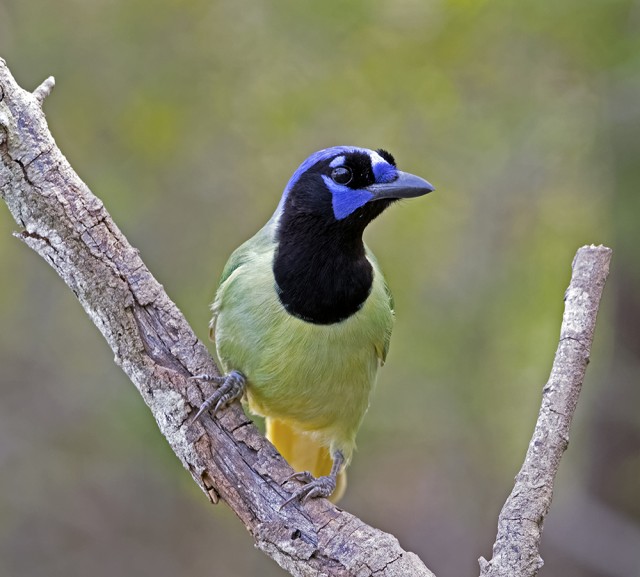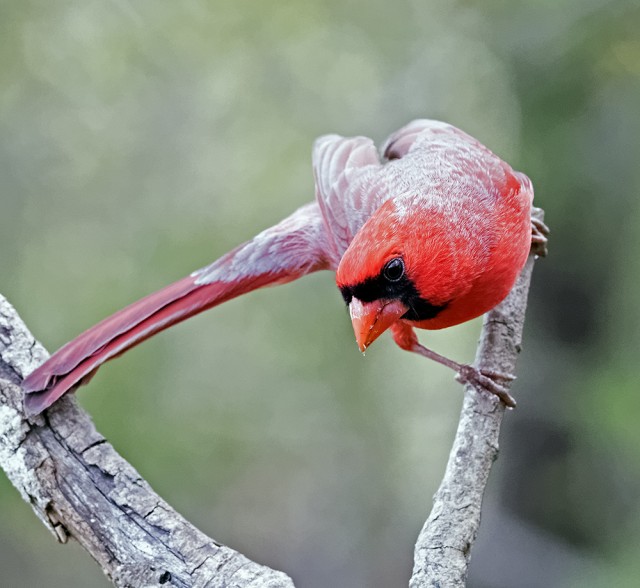
A bold and beautiful Green Jay poses for a moment before descending to a feeder. At this time of year, Green Jays readily partake of seeds. During the breeding season they make themselves scarce by hiding in the thick brush and subsisting on insects. So now is a great time to put out whole peanuts and deer corn and enjoy the holiday show! Robert Benson photo.
25 Dec 2015 – Our Local Birds Wear Christmas Colors
Christmas yard decorations are in place all over South Texas. I am sure you have noticed. Even our birdfeeders are now outfitted in red and green, the season’s brightest colors!
The red, of course, is presented by Northern Cardinals, especially the brilliant male birds. Cardinals are “frequent-feeder” birds all year round, but it seems there are more of them during the winter. Sometimes a flock of 20 or so cardinals will hang out together, creating a very colorful seasonal display. Over a dozen cardinals were at my feeders today. Our backyard Christmas decorations are now complete!
The green is provided by Green Jays. And there are definitely more of them at the feeders during the winter. Linda, a reader from Tuleta, said she had six of the extravagantly colored birds on her backyard feeder at once! With such a display, do any of us really need colored Christmas lights?
Why are there more Green Jays at our feeders in fall and winter? Do they migrate in to the area? And where have they been all summer?
Believe it or not, the Green Jay is a resident species. It is here all year long. They do not migrate, and in fact, they maintain the same territory throughout the entire year. This means that Green Jays are here all the time but are extremely secretive during the spring and summer breeding season. Typically they prefer dense thickets of brush and mesquite for nest sites. They can be seen occasionally, skulking through the trees soundlessly. During this time the jay’s diet consists of mostly insects and other birds’ eggs. While they are nesting, Green Jays are very quiet. It is almost as if they become invisible.
As the babies grow, several things happen. The jays become much more vocal and therefore more visible. Newly fledged babies move around the trees begging from their parents and last year’s offspring. At some point, the male parent chases off last year’s offspring. These yearling birds move to the edges of the territories, sometimes setting up their own new groups, but usually just hanging around as “floaters.” When the yearlings are gone, the nuclear family group consists of the two parent birds and the young birds that hatched that year. This usually makes for a group of four to six jays. The family stays together until the end of next year’s nesting season. They are very conspicuous during this time as they forage, feed and scold loudly.
If you have been reading closely, you realize that for a few weeks late in the breeding season, the family size almost doubles. Along with the mated pair, there will be last year’s babies (now yearlings) and the current year’s babies (newly fledged). This means the extended family group now contains up to 12 birds. What could be the advantage of keeping the yearlings around so long? One theory is that Green Jays are in need of all the help they can get to maintain their family’s territory, and to exclude other families. All those young jays, scolding and chasing intruders, really help to defend the perimeter.
Beginning in late summer and early fall, the jay family changes its diet. More seeds and vegetable matter are eaten. Jays seek out new food sources, sometimes becoming quite bold. Dishes of dog and cat food left outside are now “jay feeders”. Green Jays will work their way into chicken pens to feast on cracked corn and other grains. And of course they will visit a well-stocked bird feeder several times a day. This is when you can see four or more jays together. It is the “loud family” dining out.
In South Texas the early ornithologists were usually military men. Their journals describe how groups of Green Jays were common visitors to soldiers’ camps and to huts on the outskirts of towns during winter. Generally everyone found them annoying because of their “thieving propensities.” In 1878, Dr. Merrill said that these jays were “often very tame and bold, entering tents and taking food off plates or from the kitchen… (Green Jays) are caught by the soldiers in traps baited with corn, but their plumage is their only attraction as a cage-bird.” They were said to make “interesting, although noisy pets.”

There aren’t many other birds as red as a male Northern Cardinal. It is not surprising that cardinals are the quintessential Christmas card birds. This male is eyeing a platform full of black oil sunflower seeds and deer corn. Robert Benson photo.
Green Jays are only found in Mexico and South Texas. Bee County is just about the northern limit of their range. Northern Cardinals, on the other hand, are residents throughout the eastern United States and Mexico. Except for a narrow strip along the Mexican border, there are no cardinals in Arizona and New Mexico. And all of the western US north of that strip lacks cardinals. I discovered this fact when I visited my cousin in Salt Lake City last year. No cardinals at her feeder! Cardinals are depicted on so many Christmas cards, that you would think they were our national bird. It is hard to believe that the western states do not have cardinals.
However, we lucky souls here often have bright red male cardinals side by side with Green Jays on our feeders. And that is a “Hallmark greeting card” sight to see! Enjoy your South Texas Christmas! – Karen L. P. Benson
If you would like to offer comments, please click through to the discussion page
